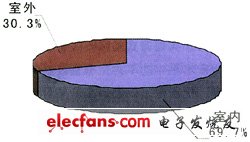In this article, based on my experience in mobile communication planning, the author analyzes the main issues of 3G indoor coverage. This includes the selection of distribution system sources, the choice of transmission media, and the sharing of 2G indoor distribution systems among multiple systems. SKT, Hong Kong SUNDAY and other mobile operators that have already established 3G networks have made some conclusions on the relevant measures and experience in the actual network construction.
1. The importance of indoor coverage
Unlike the current situation where the main business volume of the 2G network comes from the outside, the main business volume of the 3G network comes from the indoor. According to the collection results of business data from SUNDAY in Hong Kong, the indoor voice volume of 3G services accounts for more than half of the total voice volume. And NTT DoCoMo's 3G commercial network user distribution statistics show that about 70% of the business volume comes from indoors. The statistical analysis of the user distribution of 3G commercial networks is shown in Figure 1, and the details of its indoor traffic are shown in Figure 2.

Figure 1 Statistical analysis of 3G commercial network user distribution

Figure 2 Details of indoor traffic
Therefore, improving indoor coverage can not only bring users a better service experience, but also can disperse network pressure in dense areas, and can compete with other operators' networks for indoor traffic. To be sure, the improvement of indoor coverage is one of the key factors for the success of 3G.
However, because 3G works in the ultra-short wave band, and the radio diffraction ability is poor, the penetration loss is large, so there is a defect in the deep coverage of the network. Compared with the current 2G network, the 3G network will have more weak signal areas, especially in the building, there are more blind spots, easy to disconnect, and unstable network performance. South Korea's largest mobile communications operator SKT has reached a conclusion based on network management data, two national user questionnaires conducted each year, and the results of handling user complaints: most of the locations with poor service quality are indoors, while most complaints It is because users are dissatisfied with this. Therefore, 3G needs to deploy indoor coverage earlier and more comprehensively than 2G.
At present, all major mobile communication operators have a very clear understanding of the strategic significance of indoor coverage construction, and spare no effort in construction. As of the third quarter of 2005, NTT DoCoMo used 30% of the base station resources for indoor coverage, reaching a scale of 3,800 indoor distribution systems. And according to the plan, NTT DoCoMo's indoor coverage construction will continue to increase.
In the 3G network construction plan, China ’s mobile operators have paid high attention to indoor coverage and clearly proposed such a coverage goal: within 1 to 2 years, the 3G indoor coverage should reach the existing 2G in the 3G coverage area Indoor coverage level. This wish is good and the goal is correct, but there are still many problems that need to be solved in actual implementation. The main issues are discussed below.
Weichai Generator,Weichai Diesel Generator Set,Industrial Diesel Genset Powered,Diesel Genset Powered
Jiangsu Lingyu Generator CO.,LTD , https://www.lygenset.com